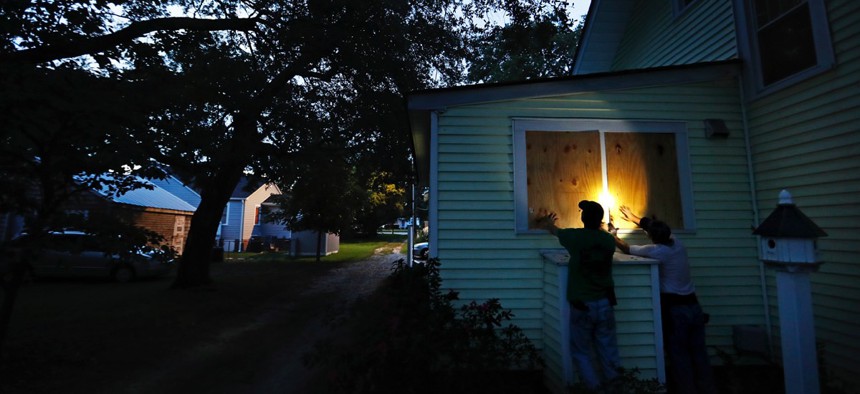Lessons from Floods Past Show Challenges With Hurricane Florence

Russell Meadows, left, helps neighbor Rob Muller board up his home ahead of Hurricane Florence in Morehead City, North Carolina on Tuesday. David Goldman / AP Photo

Connecting state and local government leaders
Louisiana and Texas are no stranger to deluges caused by prolonged rain.
Storms stalling out, dropping large amounts of rain and flooding communities—as officials warn could happen in the Carolinas with Hurricane Florence—can mean that emergency response needs to head into unexpected areas.
Storm surge along the coast is easier to pinpoint than localized rain bands delivering inches upon inches of rain over multiple days, as towns and cities in Louisiana and Texas have learned in recent years.
A large part of southeast Louisiana experienced prolonged rainfall in 2016, as did the Houston area with Hurricane Harvey’s slow progression over land in 2017, leading to catastrophic flooding in both cases. In Louisiana’s 2016 flood, the highest rainfall in the Baton Rouge area was more than 30 inches, while some parts of Texas were drenched with as much as 60 inches over four days last year.
“When you have storms that stall out, those are much more difficult to deal with; you don’t know where the heaviest rains are going to hit,” Mike Steele, a spokesman for Louisiana’s Office of Homeland Security & Emergency Preparedness, told Route Fifty. “Any time you’re talking about several inches of rainfall, there's hardly any system in America that can handle that amount of rain in a short period of time.”
Steele was en route to North Carolina because Louisiana belongs to the Emergency Management Assistance Compact, which provides state-to-state search and rescue assistance—as well as additional operations center personnel.
Models as of Wednesday show Florence slowing as it nears the coast, which will feel the worst impacts of a stalled system, then being directed south-southwest by high pressure, said Joel Cline, hurricane support meteorologist with the National Weather Service. Localities may experience a secondary wave of heavy rainfall if the storm pushes up the mountains in the western Carolinas, which coupled with intense wind could cause mudslides.
Those evacuating inland should steer clear of sounds likely to see storm surge impacts, flood-prone rivers or dams, Cline said.
Steele noted that once rain starts, in areas where roads flood quickly, emergency management officials may not call for evacuations because it’s safer to stay at home at that point.
Houston improved public education around evacuation plans in Harvey’s aftermath, said Cory Stottlemyer, Houston office of Emergency Management spokesman. Departments collaborated to identify flood-prone areas and underpasses and visualize them on an interactive map.
Stottlemyer was working in Missouri City, Texas, when Harvey hit.
“The streets were filled. The drainage system was at capacity,” he said. “Even after the rain had stopped, the water just stayed there for a while.”
Shelters quickly filled to capacity—including one before it had officially opened—and stayed open longer than anticipated, Stottlemyer said.
While Missouri City ultimately identified enough space for those displaced, Houston has ramped up efforts to coordinate supplies and shelter among volunteer and corporate donors ahead of storms because of Harvey, he added.
The Alert Houston alert system has been another municipal priority post-Harvey, Stottlemyer said, and can push notifications on a geographic basis if residents are in an evacuation zone.
Houston lies in Harris County, where on Aug. 25 voters overwhelmingly approved a $2.5 billion bond package for more than 230 flood control projects that will boost regional resilience while protecting commercial and residential investments, according to Moody’s Investors Service.
“Obviously, when your dealing with a major hurricane, there’s going to be a substantial impact to the infrastructure—loss of electricity and debris flows blocking roads,” said Mark Sloan, coordinator for Harris County Homeland Security & Emergency Management. “The public needs to listen and understand the severity of what’s about to happen.”
With Florence, inland cities like Raleigh could be dealing with a substantial rain and flooding event like Harvey, Sloan said.
Power outages make visibility an issue at night, he added.
“The immediate impact is sheltering,” Sloan said. “As we get into long-term housing, that’s when your community service agencies get involved with nonprofit organizations.”
Counties and cities need to know their hotel and apartment availability further inland, he said, which will vary along the East Coast.
Steele advises residents to always have an emergency kit handy complete with insurance paperwork, birth certificates and information on any prescriptions they might need.
But complying with evacuation orders remains most critical.
“Understand that if you stay when evacuations are mandated, help may not be readily available,” Steele said. “First responders may not be able to get to you.”
Dave Nyczepir is a News Editor at Government Executive’s Route Fifty and is based in Washington, D.C.

NEXT STORY: What Comes Next As States Meet Renewable Energy Goals?





